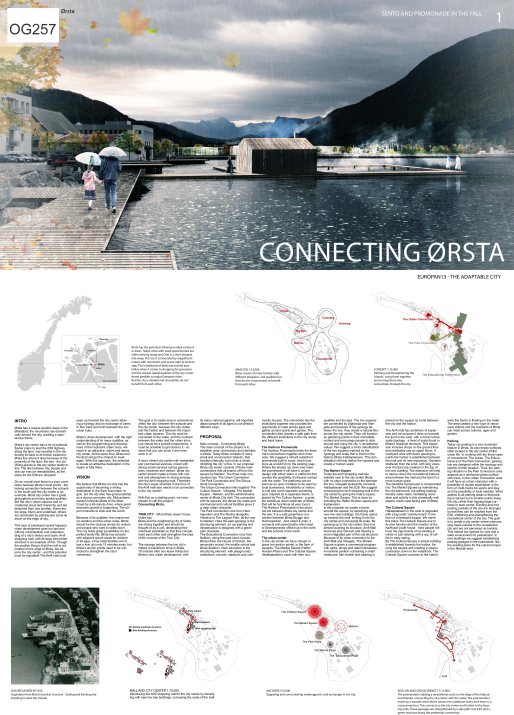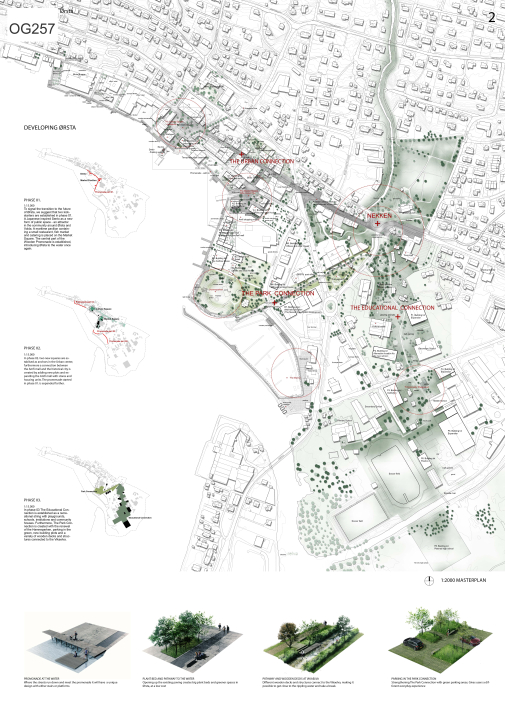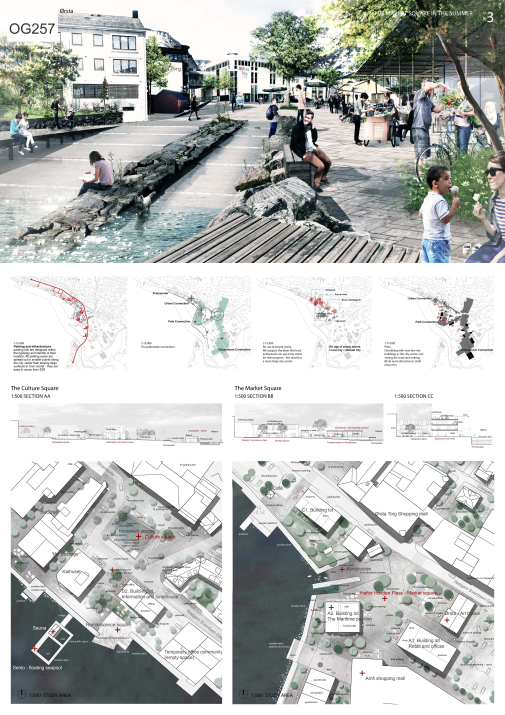Project:
Connecting Ørsta
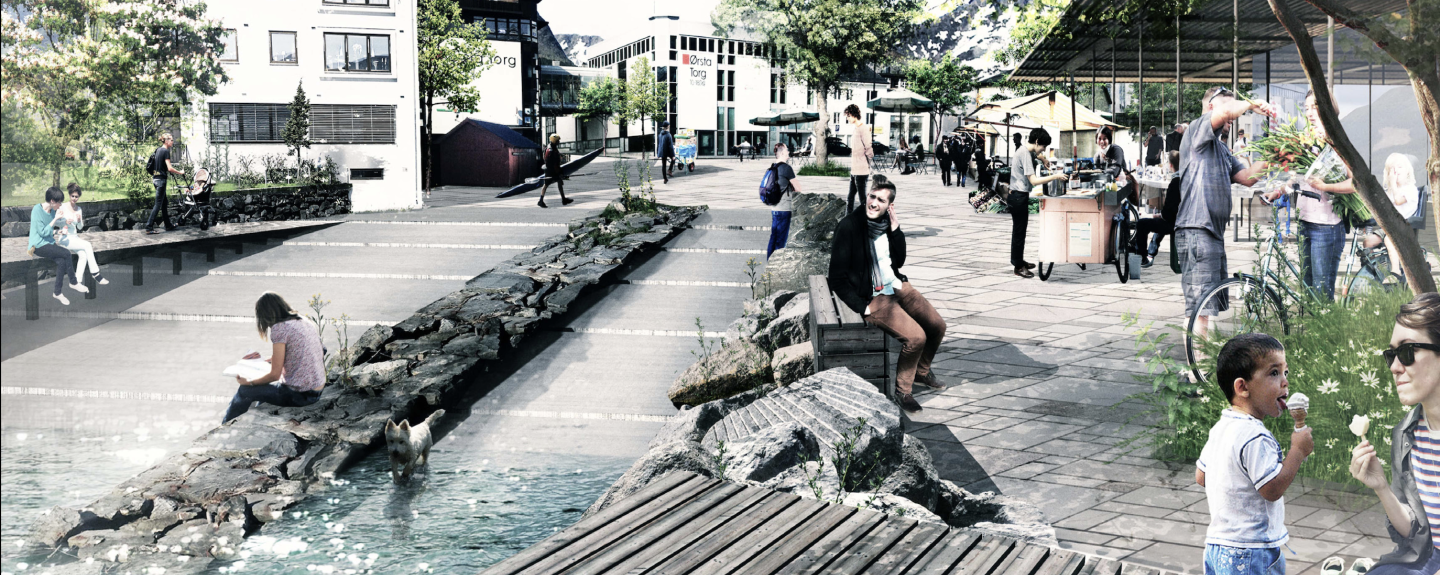
About
-
Main concept - Connecting Orsta
The main concept of the project is to establish clear connections and identities in Ørsta. Today Ørsta consists of many small and unconnected 'islands', that function internally, but not as a whole, inhibiting the city Is flow. In our proposal Ørsta city centre consists of three main connections that all branch off from the square by Nekken. The three main connections are: The Urban Connection, The Park Connection and The Educational Connection.
The Urban Connection links together The Culture Square - Vikegata, The Market Square Nekken, and the administrative center at Ørsta City Hall. The connection with its squares, the dense city scale and commercial and cultural facilities gives it a clear urban character.
The Park Connection runs from Hamneparken and The Marina alongside Vikeelva to The Lagoon Park, all the way to Nekken. Here the park-typology is the structuring element, so car-parking and infrastructure is designed with a green park character.
The Educational Connection runs from Nekken, along the park block houses, Ørsta Hotel, the House of Culture, the secondary school, the middle school and Ørsta Stadium. Here education is the structuring element, with playgrounds, institutions, schools, stadiums and community houses. The connection ties the institutions together and provides the opportunity to meet across ages and gather around sports and games. The connection also creates a safe path from the different institutions to the city centre and back home.
The Harbour Promenade
The Harbour Promenade binds the three main connections together and crosswise. We suggest a vibrant waterfront promenade built in wood, which functions as an Add On to the existing quay.
Where the streets run down and meet the promenade it will have a unique design with either stairs or platforms that creates the possibility of physical contact with the water. The platforms can be seen as an open invitation to be used by local businesses, inhabitants or visitors.
A cold and warm seawater swimming pool, inspired by a Japanese Sento, is placed by The Culture Square - a quiet, but ambitious urban landmark of Ørsta, that will be functional all year round.
The Harbour Promenade is the physical link between Ørsta city center and the sea. It is a safe green/blue connection between Orsta Brygge and Hamneparken. And where it ends, it connects with paved paths which lead to Strompenester office hub in the north and the schools in the south.
The urban center
In the city centre we have chosen to place two anchor points, in the form of squares; The Market Square (Haftor Hovden Plass) and The Cultural Square (Haldepladsen), each with their own qualities and focuses. The two squares are connected by Sjobrauta and Vikegata and because of the synergy between the two, they create a natural flow across the city center. They will function as gathering points in their immediate context and encourage people to stick around and enjoy the city 's recreational values. We suggest a minor densification of the two squares inspired by the typology and scale that is found in the historic Orsta (Haldeplassen). This densification will help define the squares and create a 'human scale'.
The Market Square
Today the Amfi shopping mall lies isolated next to the city center Ørsta, with no clear connection to the between the two. Vikegata awkwardly connects Haldeplassen and the E39. We suggest introducing the Amfi shopping mall to the city centre by giving the mall a square, The Market Square. This is done by including the Haftor Hovden square and Kyrkjevoren.
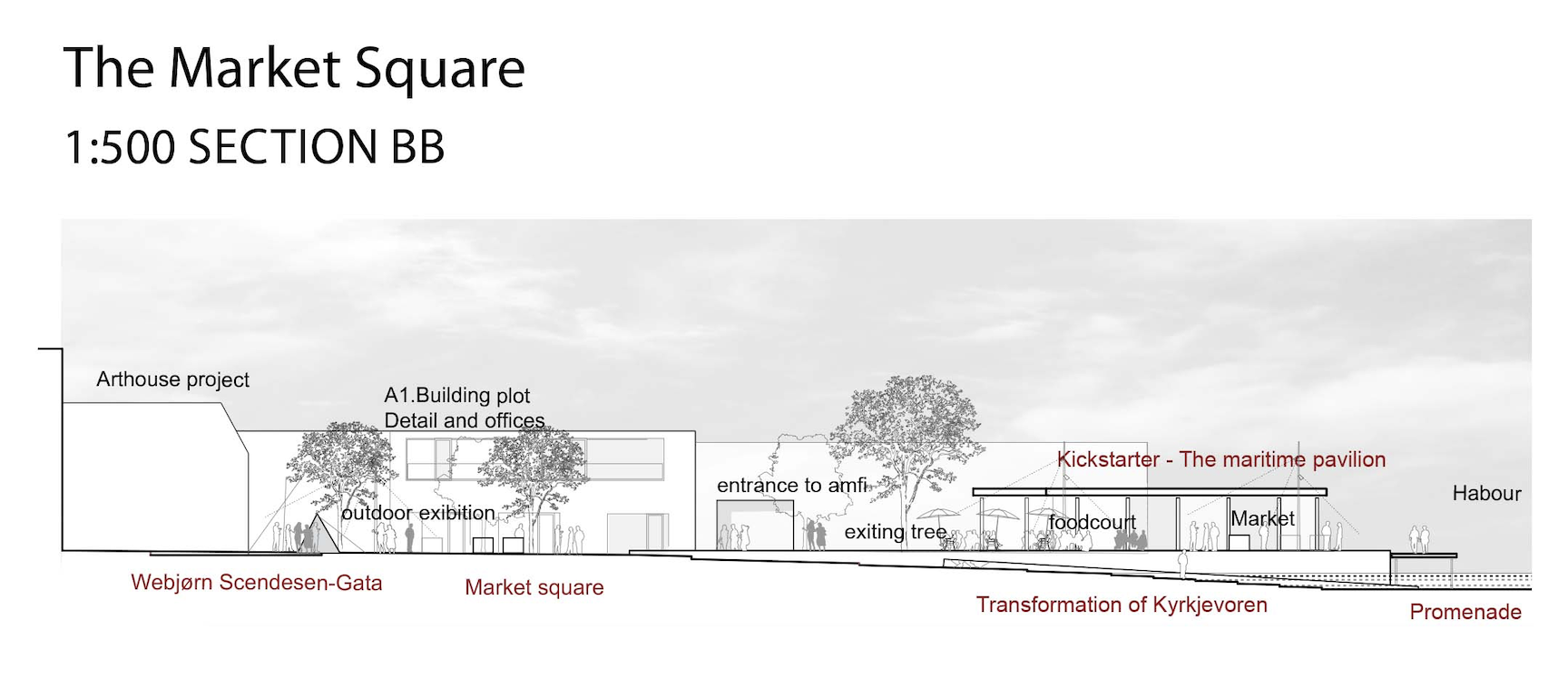
The Cultural Square
Haldepladssen in the west is upgraded with a big scale "activity board" in the form of a recessed square. We name this place The Cultural Square due to its new function and the location of the KaiHuset youth house - here people will have the opportunity of ice skating in winter or just relaxing with a cup of coffee in early spring.

Parking
Today car parking is a very dominant feature in Ørsta, its vast empty surfaces often located in the city center inhibit urban life. In working with the three types of connections; The Urban, The Educational and The Park Connection, parking lots are designed within the typology and identity of their location. Thus, the parking situation in the Park Connection area appears as a reinforced grass surface with trees. In the Urban Connection area it will have an urban character with a possibility of double exploitation in the form of multi-tracks for sports and play, and the possibility of local markets. What applies to all parking areas is that parking is spread out in smaller points along the city, rather than staying large surfaces in town center.

-
Connecting Ørsta presents an overall plan for both the site and study area, showing a good understanding of the local challenges and the scale of the town. The project proposes to create a new spatial hierarchy in Ørsta by establishing three, new main connections across the central areas: the urban connection, the park connection and the educational connection.
While the urban and the park connection propose structural interventions, the educational connection proposes a new programmatic rearrangement strengthening the relations between the schools, the cultural house and the town centre. The strategic locations of these connections are based on an intelligent analysis of the place, and the proposed physical interventions are transforming the whole logic of the site with credible means. Furthermore, the project takes on Ørsta’s car based culture by introducing a strategy on how to integrate parking within the proposed green and urban structures.
The project shows sound strategies for how to link the different inherent urban, natural and scenic conditions of Ørsta with the aim of increasing the town’s position as a destination and regional centre in Søre Sunnmøre. This focus on strengthening the connection between the educational institutions and the centre is vital to activate the town at daytime. The proposed design of these spaces is also operative as it is making a clearer distinction between the front and the back of the mixed-use blocks in Ørsta’s centre, and turning many grey asphalt zones into recreational areas optimized for new and green mobility.
The phased development of implementation includes ideas on how micro-scale interventions can improve existing conditions. The jury believes that the project can become an effective planning tool for the municipality of Ørsta, both in a short- and long-term perspective.
-
Team representative: Jens Nyboe Andersen (DK) – landscape architect; Associates: Karl Johan Baggins(DK) – landscape architect; Maria Crammond (DK) – architect
Kronprinsessegade 10, 3 tv, 1306 Copenhagen – Danmark
+45 405 04 948 – jensnyboeandersen@gmail.com
J. Nyboe Andersen, M. Crammond & K. J. Baggins
Team interview
1. How did you form the team for the competition?
We know each other from the School of Architecture and University of Copenhagen. We have worked together in teams across offices and on our own, besides our jobs, during competitions.
When Europan 13 was launched, we were working for different offices across Copenhagen. We created a workstation in Jens’s apartment and spent a lot of weekends together coming up with our proposal for the competition.
2. How do you define the main issue of your project, and how did you answer on this session main topic: Adaptability through Self-Organization, Sharing and/or Project (Process)?
We had long discussion about the main topic, the adaptable city in relation to the site, Ørsta. But we did not make it control our design process. We wanted to do what we thought would be the right thing for Ørsta. By that our proposal answered the main issue by itself.
Three main connections – the Urban Connection, the Park Connection and the Educational Connection – define and strengthen the center of the town, tying together what today appear as divided islands with different programs. Besides, a Harbour Promenade binds the connections together and crosswise; functioning as an Add-On to the existing quay, it is the physical link between Ørsta center and the sea.
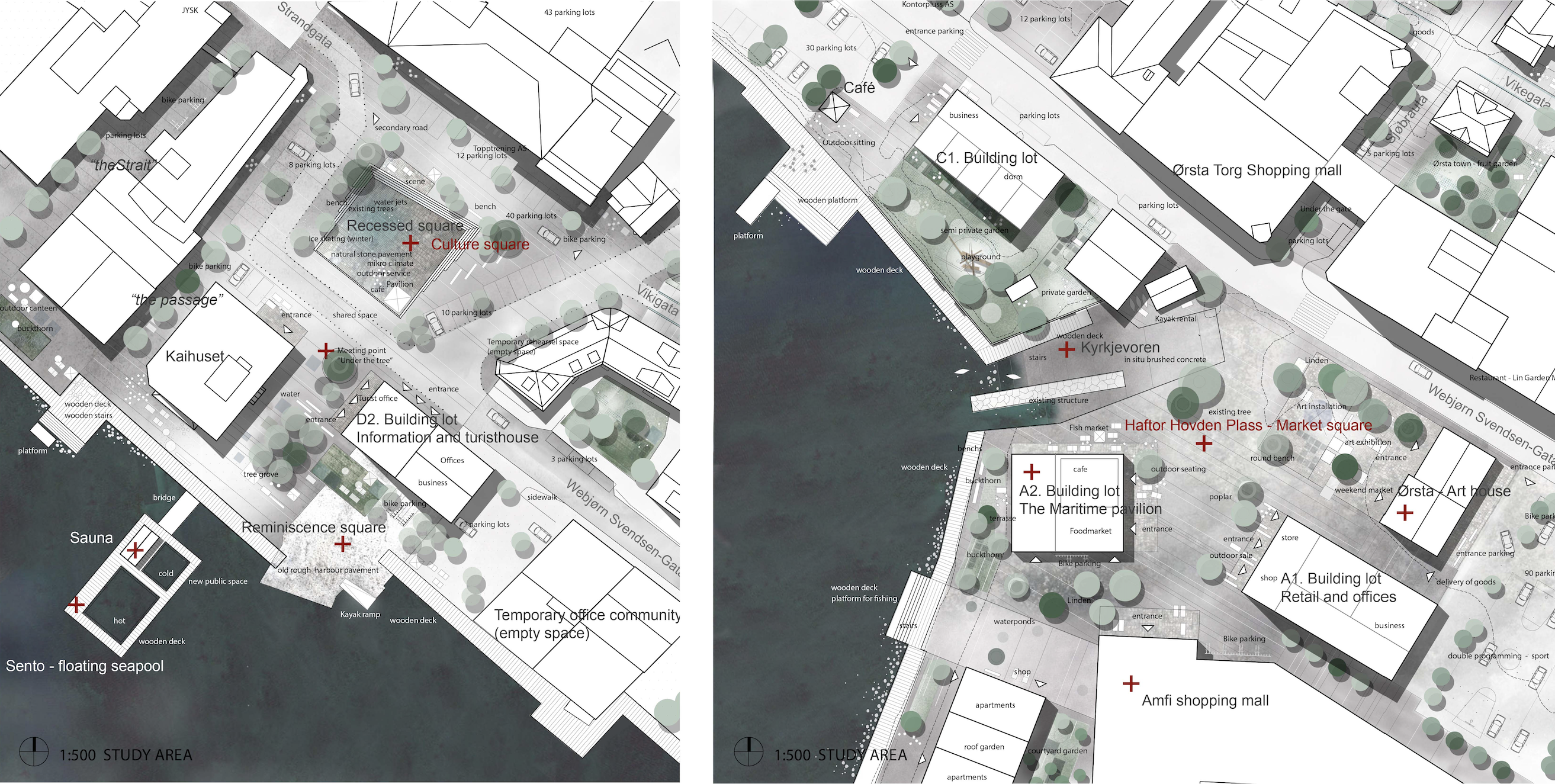
3. How did this issue and the questions raised by the site mutation meet?
Ørsta has through its evolution ‘mutated’ from a town based on the harbour industry and the important connection to the sea to a town that turns its back to the sea and has no real use for the old industrial areas that make up the existing harbour front. So the issue meets the site mutation really well as the town has to adapt and find a new way of exploiting the great potential of its ‘forgotten’ harbour front.
4. Have you treated this issue previously? What were the reference projects that inspired yours?
We think that adaptability as a topic is something that comes up in most of our work processes. Often when you develop a new site, you do so because it has to adapt to new issues.
The physical issues of Ørsta are not new to us since we have worked with similar projects in our professional work. We were not inspired by one specific project, but by many! It is hard to mention one that has had a bigger influence than others.
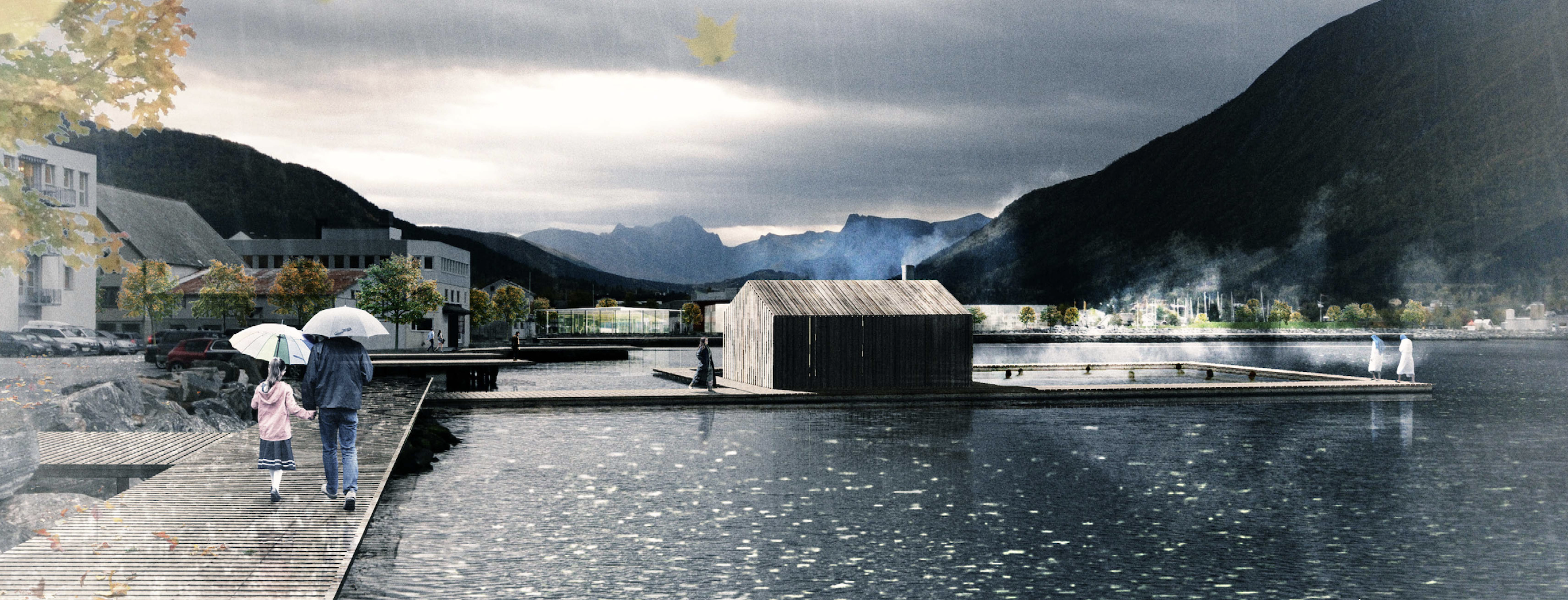
5. Today –at the era of economic crisis and sustainability– the urban-architectural project should reconsider its production method in time; how did you integrate this issue in your project?
In Copenhagen it is hard to talk about a crisis at this point – yet, we all graduated in a time were the economical crisis could be felt, and this has shaped the way we think about architecture and urban design.
Sustainability wise we have worked with Ørsta in a pragmatic way –we do not suggest to demolish and rebuild, but rather reuse and acknowledge the excellent frames that make up the towns spatial qualities.
Sustainability often gets challenged when it comes to economy. So when implementing our proposal for Ørsta it is important to have realistic ideas on how to actually succeed in building the project in a sustainable way.
6. Is it the first time you have been awarded a prize at Europan? How could this help you in your professional career?
Yes, it is the first time we have been awarded at Europan. It is a unique possibility for us to work on our own and shape a project from the very beginning and we are certain that we can learn a lot from the upcoming process. We have already had a great response from colleagues and friends in the professional field in Copenhagen and are all exited to see where this project can lead us to.
Related projects
-

Connecting Ørsta
The main concept of the project is to establish clear connections and identities in Ørsta.
-
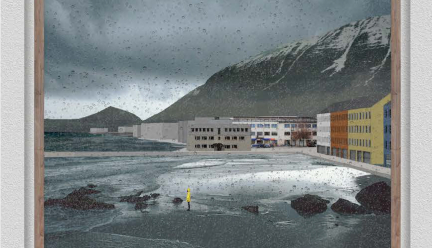
Utmark
This project proposes to explicitly reverse the haphazard way that exemptions to the freedom to…
-
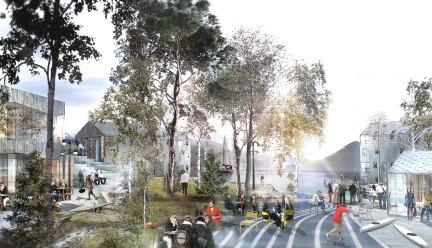
Urban By Nature
An intensified natural setting that creates urbanity, enhances the shopping conditions and attracts…
